The Cultural Properties of Keio University
Keio University possesses a total of nine national treasures and important cultural properties. They include two buildings, four items stored in the library, two archeological findings, and the Akikusamon Bottle, which is a national treasure. Cultural properties are designated as either “national treasures” or “important cultural properties,” with national treasures being important cultural properties that have exceptional artistic or academic value.
This edition of Keio View will present the cultural properties that are in Keio University’s possession.
Buildings
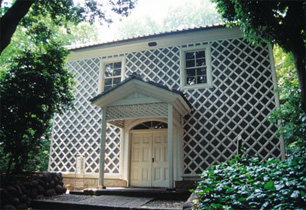
The first attempts at giving “speeches” in Japan were made in 1874. These attempts were initiated by Yukichi Fukuzawa and his pupils, studying Western speech and debate methods. The next year (1875), a “speech society” was established, and this speaking hall was built in the following year (1876). Originally standing between what is now the Old University Library and the Jukukan-kyoku building, it was moved to its current location in 1924. The building later underwent renovation in 1947 and dismantling and restoration in 1995. It attained its present appearance in April 1997.
Built in Western style, the building with wooden structure has a tile roof and namako-kabe walls. The building partially has two stories, with a floor space of over 58 tsubo (192.16 m2), or over 87.9 tsubo (290.34 m2) including the attached building. It is said that drawings of various halls were brought in from the United States for reference in designing the building, and cost more than 1,000 yen to build. It was designated an important cultural property in June 1967. Mita Enzetsu-kan is currently used as the venue for biannual meetings of the Mita Oratorical Society (spring and autumn), Yukichi Fukuzawa-Francis Wayland Memorial Lecture, and other events.
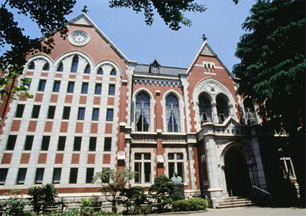
The Old University Library was built in April 1912 to commemorate the 50th anniversary of the university’s founding. Designed by Tatsuzo Sone and Seiichiro Chujo, it was built by Todagumi with a budget of 230,000 yen, entirely from contributions. Although damaged in the Great Kanto Earthquake and World War II, it maintains its original shape today.
Designed in pure gothic style, it is a magnificent building with walls of red brick and granite featuring a large, beautiful clock on its exterior. It was selected as an important national cultural property on March 12, 1969, as a typical brick construction of the late Meiji Period. It is currently used to store the university’s library collection and as a meeting hall. The stained glass work entitled “The Pen is Mightier than the Sword” is situated above the stairway of the entrance hall and serves as the symbol of the university.
Items Stored in the University Library
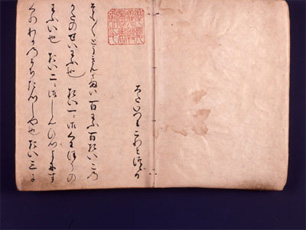
Ota Gyuichi was born in Owari and became a monk in Yamadanosho Jokanji Temple, where he served Nobunaga. He later led a life of seclusion in Iga after the incident of Honnoji Temple. In 1596, he was summoned by Hideyoshi and was appointed to Izumiji Temple. He continued to serve Hideyori even after Hideyoshi's death.
The manuscript measures 21.0 cm by 11.7 cm. The cover is made of thick tanned torinoko paper. The script of the main text is largely written in hiragana. It praises the virtues of the Emperor, and records various events that include a rebellion against Hidetsugu and his tragic downfall; historical views of the rise and fall of Okuo, Miyoshi, Matsunaga, and Saito Dosan; the Mitsuhide Rebellion; the Odawara Expedition; an Imperial visit to the mansion of Toyotomi Hideyoshi; the Seikan war; the building of Fushimi Castle; the births of young lords; and cherry blossom-viewing at Daigoji Temple. They give truthful accounts of the time that are fascinating to read today. Designated an important cultural property in June 1974, the manuscript is currently stored in the Rare Book Room of Keio University Library.
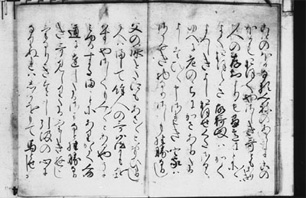
Gotobanoin Gosho, is said to have been written by the ex-Emperor Gotoba. It notes information on waka poems and contains comments on contemporary poets. Koshibe Zen’i Shosoku is both an appraisal of a long line of selections and a letter to Fujiwara no Tameie, nephew of Fujiwara no Toshinari (from the Mikohidari family, descendents of Michinaga; father of Sadaie) that was written by Toshinari’s adopted daughter, Koshibe Zen’i, when Tameie completed his work Shokugo Senshu.
This writing is a combination of both Gotobanoin Gosho and Koshibe Zen’i Shosoku. The works were copied together by a person under the direction of Ton’a, the primary figure among tanka poets between the late Kamakura Period and the Period of the Northern and Southern Dynasties. It is an important material in the history of poetic theory in that it includes a postscript bearing Ton’a’s own signature dated September 9, 1351.
The exterior box is made of paulownia and the interior box is finished with black lacquer. The boxes are both inscribed with the words “Gotobanoin Gosho and Koshibe Zenni Shosoku Postscript by Tona,” in black on the exterior box and gold paint on the interior box. The covering paper measures approximately 20.6 by 14.2 cm and is arranged with decorative illustrations. Declared an important cultural property in June 1974, it is currently stored in the Rare Book Room of Keio University Library.
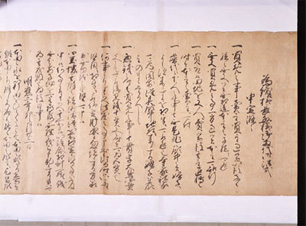
The “Documents of the Sagara Family” is a collection of 1,200 items of the Sagara family of Hitoyoshi, southern Higo Province in Kyushu, that date from the Kamakura Period to the Edo Period. The items include letters that were sent to the heads of the Sagara family over the generations from various families, orders from the Imperial court and shogunate, and rough drafts of letters that were sent by family heads to various people. The Sagara family was a local ruling family that controlled territory in Higo from the beginning of the Kamakura Period, and it served the shogunate as steward of this region. Moreover, after continuing in this capacity during the Period of the Northern and Southern Dynasties, the Muromachi Period, and even the difficult Warring States Period, the family became the Higo Daimyo (holding 22,000 koku of rice) at the beginning of the Edo Period. The family retained this status until the Meiji Restoration. Thus, the Sagara family is a rare example of family longevity in Japan, as it was constantly associated with this region for over 700 years.
All of the writings in this collection are uniform and in good condition. They are valuable historical materials in the understanding of political, economic, and cultural trends during Japan’s feudal past. The university’s collection includes 63 items from the Kamakura Period, 128 items from the Period of the Northern and Southern Dynasties (from the times of Kenmu to Genchu Meitoku), some 500 items from the Muromachi Period and Warring States Period (until 1582), and some 500 items from the Edo Period and later. Designated an important cultural property in June 1977, the collection is stored in Rare Book Room of Keio University Library.
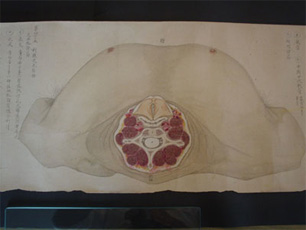
The Kaibo Sonshinzu is a collection of color anatomical drawings on two scrolls by Minagaki Yasukazu, a doctor of the late Edo Period. The collection was intended to cover inadequacies in the results of dissections conducted by Koishi Genshun, a doctor from Kyoto. Taking the Western-style anatomies of the German doctor Johann Adam Kulmus and others that appeared in Anatomische Tabellen as a reference, the collection is significant in that it includes illustrations by the doctor himself based on observations of individual organs from more than 40 bodies. Containing 83 illustrations, it is said to be the best collection of anatomical drawings by a Japanese hand from the early 19th Century.
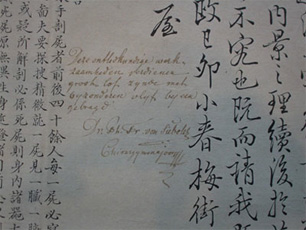
The collection also contains compliments written in Dutch by Philip Franz von Siebold as well as postscripts by Udagawa Genshin and Otsuki Gentaku. It is deemed to be extremely significant in the history of Japanese medicine as a material that demonstrates how far practical anatomical drawings had progressed during the Edo Period. Designated an important cultural property in March 2003, it is currently stored in The Rare Book Room of Keio University Library.
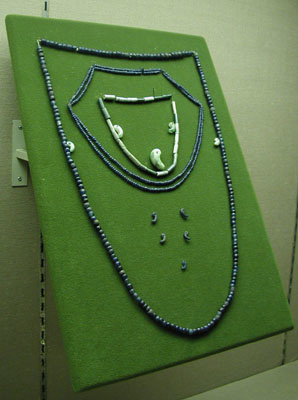
The Hiyoshi Yagami Tumulus was discovered by accident on October 8, 1936, when Masaki Masato and Matsumoto Nobuhiro, both professors of Keio University’s Faculty of Letters, took students on an investigation to the Yagamiyato Shell Mound, located on a hilltop some 700 meters north from Preparatory School of Keio University at Hiyoshi campus site. The professors were making their first visit to the site after a long interval. At the time, work was progressing toward construction of the campus grounds; however, a survey was commenced from October 14 with the approval of various officials. The actual excavation was conducted on October 15 and 16.
The interior of the mound was a small round area with a diameter of 25 meters. It had a clay floor and a height of less than four meters. However, both the volume and quality of the items buried inside were of a magnificence never before seen at the time. Recovered items included two copper mirrors, some 1,700 beaded items, one iron sword, and one bamboo comb. The fact that the copper mirrors are exceptional examples of imitative bronze mirrors, that both mirrors were made from the same mold, and that the finding contained abundant types and numbers of beaded items (including lapis lazuli stones and beads) led to the collection’s being designated a national treasure in May 1940. This designation was later changed to important cultural property status in 1953.
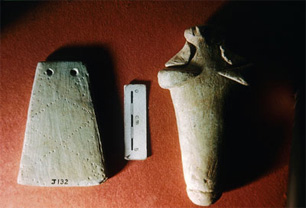
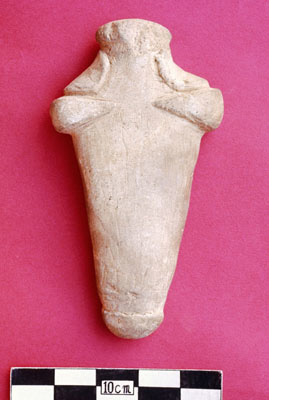
Stone figurines (gangu) are human forms made from soft lithic sandstone or tuff-mudstone. Stone tablets (ganban) are items that are square or elliptical and are made with the same stone materials as gangu. Both gangu and ganban are thought to be religious relics. The gangu and ganban belonging to Keio University that are designated as important cultural properties were excavated from Aza-Uchinotai, Oaza-Sugisawa, Kosaka-machi, Kazuno-gun, Akita Prefecture (in the foothills near Lake Towada). They are estimated to date from the end of the early Jomon culture years.
The gangu has a height of 15 cm and a thickness of 2.5 cm at its thickest point. No eyes, nose, ears, or mouth are expressed on the head. Both arms are extended out from the sides and bent at the elbows, with the hands touching the chest. The ganban is 10.2 cm high and is 1cm thick around the central area. There are two holes of about 0.5 cm located on the upper part of the tablet. Fine dotted markings that are exact copies of patterns on cylindrical earthen vessels are visible on both sides. These two items were designated an important cultural property in June 1974.
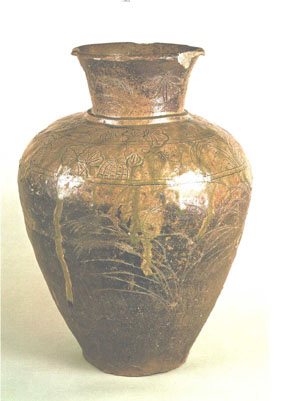
The Akikusamon Bottle was discovered by chance in April 1942. It emerged during a digging construction from the lower side of the rear rounded part of Hakusan Burial Mound, located on the eastern side of a hill called Mt. Kaseyama, about 1.5 km east southeast of the Hiyoshi Campus. The bottle, which was recovered in its complete form, is thought to have been buried as a funerary bottle because it had been placed in remains made up of piled riverbed rocks covered with clay, and because it was filled with cremated human remains. It has a height of 42 cm, a neck diameter of 16 cm, a body diameter of 29 cm, and a base diameter of 14 cm. It has a beautiful shape marked by a mouth that bends slightly to the outside, a bulging upper body, and a narrowing base. Moreover, it is covered with green glaze and features drawings of such autumn grasses as Japanese silver grass and melon that were drawn into it with a spatula. The kanji character “上” (up) is written with a spatula on the inside of the mouth’s edge. It is thought to have been fired in an ancient kiln in Tokoname, Aichi Prefecture, around the last half of the 12th Century, around the end of the Heian Period. It was designated a national treasure in March 1953. It is currently in the Tokyo National Museum, where it is occasionally placed on exhibit.
(Because exhibits are changed regularly, please confirm that the urn is on display by calling the Tokyo National Museum before visiting. Tel.: 03-3822-1111)
Keio University possesses many other rare writings in addition to these cultural properties. Please see the HUMI Project Webpage for details.
